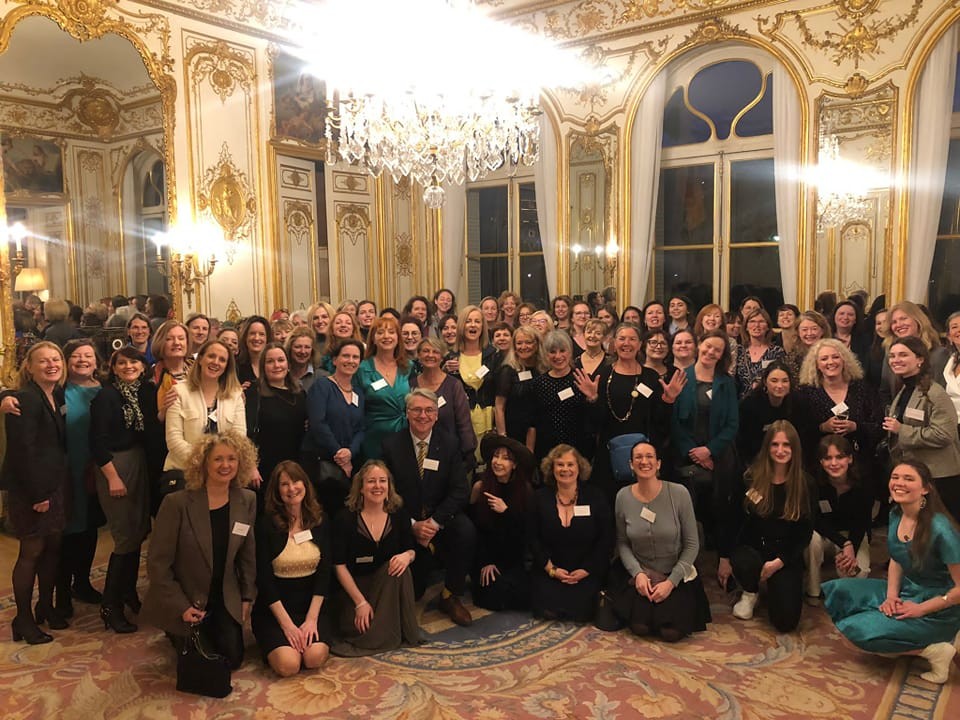
By Patricia Killeen
Almost 100 Irish women stepped out recently to the Irish embassy, housed in the elegant Hôtel de Breteuil heritage building, in Paris.
The joyous occasion was organized by Shauna Kelly-Lefevre, leader of Mná na hÉireann, France.
The Mná were warmly welcomed to the embassy by embassy staff and volunteer Mná na hÉireann meeters and greeters, County Clare woman Margaret O’Sullivan from Sixmilebridge and Patricia Caviston from Dublin. For many of the Mná, especially for the younger generation, it was their first time visiting the Irish embassy in Paris.
Mná na hÉireann was created in France in 2016 by Shauna Kelly-Lefevre and flourished as a WhatsApp group during the Covid lockdown. The raison d’être of the Mnáwesome group is to “stay connected and together under all skies, whether blue, grey, or dark. Support thanks to togetherness is the main goal of the Group”. There are currently 160 Mná in the group, residing throughout France. With dynamic momentum, the group continues to increase every week. The number of Irish people currently living in France is estimated at around 25,000.
After banter and enjoying delicious canapés (including Irish cocktail sausages, served on a silver platter, as the uncontested stars of the buffet) Mná gathered to listen to H.E. Niall Burgess speak. H.E. Burgess, who became Ambassador of Ireland to France in December 2021, said he was impressed by the Mná group, portraying the strength of our Irish community under the shadow of the global pandemic and providing such shelter and support. He reminded us of the Irish expression; “Ar scáth a chéile a mhaireann na daoine”, meaning we live protected under each other’s shadow.
As we emerge from the pandemic, he advised that we “be attentive, be ambitious and be at home”. In Paris, the Irish are lucky to have two beautiful “homes”, the Embassy on the right bank and the Irish Cultural Centre (under the direction of Nora Hickey M’Sichili) on the left bank.
The Mná na hÉireann in France, has been the first such group to emerge in any community outside Ireland since the pandemic. The eclectic diversity and age range of the women, hailing from all parts of Ireland, (the Banner County is well represented) and with experience in so many domains, makes the “skilled to the hills” group extremely interesting.
I reflected on other Irish women who had also lived in France; Maud Gonne; Countess Markievicz; Eileen Grey, architect; Hannah Lynch, writer; Katherine McCarthy and Maureen Patricia O’Sullivan who served the cause of the liberation of France during WWII.
Her story highlights the link between Irish women in France and their embassy. On New Year’s Eve 1940, the pregnant Kelly was rescued from a prisoner of war camp, in Besançon, by Count Gerald Edward O’Kelly, a former Irish diplomat. He secured her release by procuring for her (and for many others) a neutral Irish passport. Kelly, was holding a British, “enemy of the third Reich” passport when arrested.
After H.E. Burgess’s opening remarks, Shauna Kelly-Lefevre explained the evening’s program designed to ensure all attendees could contribute to this unique opportunity. Four break-out rooms were used to facilitate discussion, capitalize and collect members’ feedback and brainstorm on how to harness the energy and talent of the group and decide the Mnà’s next steps in France. Róisín Dockery, Carmel Keane, Pamela Boutin-Bird, and Triona Campbell led the break-out rooms, and summarized when we all reunited
There were interesting recommendations from each group, with a definite, clear common denominator; to hold onto the craic, banter, mutual support and the WhatsApp group as we grew. A members’ directory was suggested, as was a Mná website, or other platform, to enable easier access to contacts, partner services, promote events, share job offers, etc.
The warmth of the group, and its exponential growth during the pandemic proves that clouds often do have a silver lining. In addition, Brexit has, and continues to create opportunities and interesting new career paths for the Irish diaspora in France. The soft-power and extensive information available from the Mná already on the ground, is invaluable for new Irish women arriving in France.
Before I left the embassy, I realized that H.E. Burgess, who played an active role in the Irish peace process, and participated in the Good Friday Agreement, was also a descendant of the 1916 Rising hero Cathal Brugha (Burgess in Gaelic).
Our 1916 leaders, offered a first and revolutionary mention of Irish gender equality, when they addressed the Proclamation of Independence to “The People of Ireland – Irish men and Irish women”, and promised “religious and civil liberty, equal rights, and equal opportunities to all its citizens”. 1916 leader, Countess Markievicz, who studied art at the Académie Julian, Paris, was one of the first women in the world to hold a cabinet position, as Minister for Labour, from 1919–22. Today, Geraldine Byrne Nason, a former Ambassador of Ireland to France, is Ireland’s Permanent Representative to the United Nations (since 2017).
Our evening ended with a spontaneous, ethereal rendition of “The Parting Glass” by Louise Taylor-Scott, and it seemed as if she was paying homage to how past, present and future Mná na hÉireann’s, green imprints left, and continue to leave, such an impression on the Hexagon.
With Covid restrictions lifted, thankfully it’s no longer “such a long, long way” from Clare to Paris and I’m very much looking forward to revisiting the Burren, the Cliffs of Moher and of course Lisdoonvarna, in September 2022.
By Patricia Killeen, Paris – Host of the “Turning Points” radio show on World Radio Paris (http://worldradio.fr/)